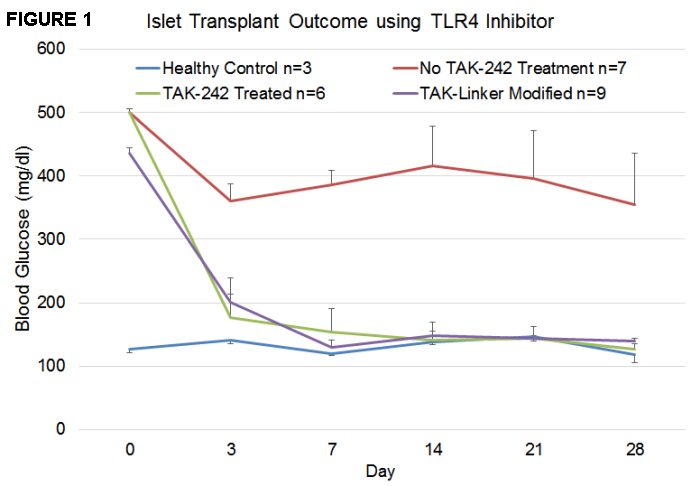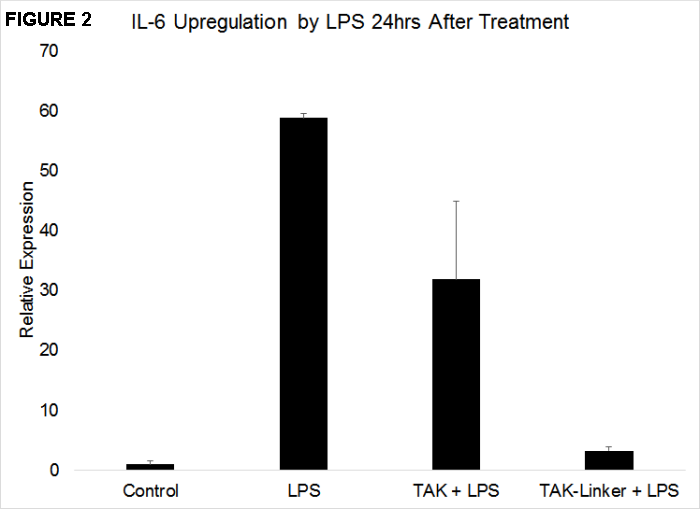The Role of Toll-Like Receptor 4 in Islet Transplantation and a Novel Method of Protection Using Chemical Surface Modification.
1Institute of Biomedical Studies, Baylor University, Waco, TX
2Baylor Scott and White Research Institute, Dallas, TX
3Baylor Simmons Transplant Institute, Dallas, TX
4Department of Chemistry and Biochemistry, Baylor University, Waco, TX
Meeting: 2017 American Transplant Congress
Abstract number: A33
Keywords: Graft survival, Inflammation, Islets, Rejection
Session Information
Session Name: Poster Session A: Cellular & Bone Marrow Transplantation Session I
Session Type: Poster Session
Date: Saturday, April 29, 2017
Session Time: 5:30pm-7:30pm
 Presentation Time: 5:30pm-7:30pm
Presentation Time: 5:30pm-7:30pm
Location: Hall D1
Toll-like Receptor 4 (TLR4) is the canonical receptor for lipopolysaccharide (LPS), however recent evidence reveals that TLR4 also plays an important role in ischemia-reperfusion injury (IRI). TLR4 is suggested to play a key role in acute graft failure. Here, we demonstrate that treatment with a clinically-tested, small molecule TLR4 antagonist (TAK-242) protects transplanted islets from the inflammatory effects of DAMPs and IRI. To do this, we challenged mouse islets in vitro with LPS or whole blood +/- TAK-242 to demonstrate both the sensitivity of islets to TLR4 stimulation as well as the efficacy of TAK-242 as a TLR4 antagonist. Then we transplant a marginal dose of islets +/- TAK-242 treatment into a diabetic mouse model to show both the safety and efficacy of TAK-242 in protecting islet grafts (Fig1).
To localize and prolong the protective effects of TLR4 inhibition, we developed a linkable variant of TAK-242. To test this compound, islets modified with this compound were both tested in vivo (Fig1) and challenged in vitro 24hrs after modification and compared to non-treated and islets treated previously (Fig2). In vivo TAK-linker modified islets effectively restored normoglycemia and significantly blocked IL6 secretion from LPS-stimulated islets in vitro.
The results from these experiments demonstrate that TLR4-blockade improves islet graft function and this novel chemistry has the potential for application in islet as well as whole organ transplant.

CITATION INFORMATION: Chang C, Yoshimatsu G, Akinbobuyi B, Lawrence M, Kane R, Naziruddin B. The Role of Toll-Like Receptor 4 in Islet Transplantation and a Novel Method of Protection Using Chemical Surface Modification. Am J Transplant. 2017;17 (suppl 3).
To cite this abstract in AMA style:
Chang C, Yoshimatsu G, Akinbobuyi B, Lawrence M, Kane R, Naziruddin B. The Role of Toll-Like Receptor 4 in Islet Transplantation and a Novel Method of Protection Using Chemical Surface Modification. [abstract]. Am J Transplant. 2017; 17 (suppl 3). https://atcmeetingabstracts.com/abstract/the-role-of-toll-like-receptor-4-in-islet-transplantation-and-a-novel-method-of-protection-using-chemical-surface-modification/. Accessed December 23, 2025.« Back to 2017 American Transplant Congress
